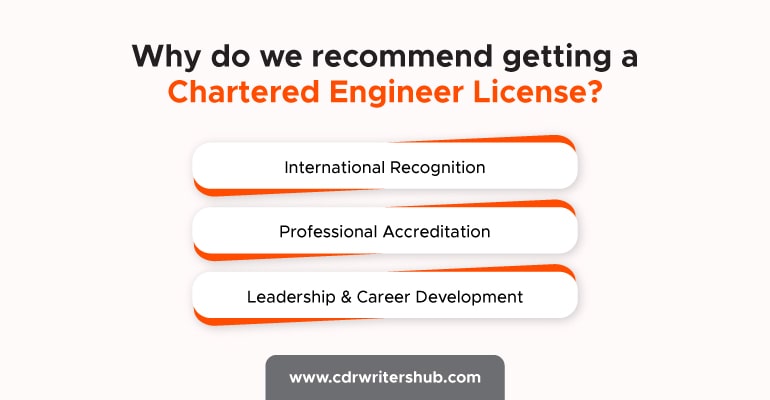Everything to know about the pathways to becoming a chartered engineer in Australia

Everything to know about the pathways to becoming a chartered engineer in Australia
Becoming a chartered engineer in Australia is a great way to jumpstart your engineering career and gain a competitive advantage by establishing yourself as a knowledgeable, experienced, and tested engineer in your field. Your chartered credential is a ticket to global opportunities as a recognized engineering consultant, manager, and leader because Australian Chartered engineers are recognized globally. This blog will cover the various pathways to chartered engineer will cover the various pathways to becoming a chartered engineer in this blog, including educational requirements, professional growth, and job experience.
An Australian Chartered Engineer license is a fantastic way to get your engineering career off to a great start. It establishes engineers as experienced, professional, and competent engineers in expertise. The Chartership is a professional recognition given to skilled, creative, and inventive engineers. Engineers Australia, Australia’s largest professional community of engineers, provides its members with the opportunity to earn the title of Chartered Engineer, which comes with a variety of benefits. There are three occupational categories in which the chartered certification can be obtained:
- Chartered professional engineer
- Chartered engineering technologist
- Chartered engineering associate
All of the above occupational categories have a similar application process; however, the competency elements might very well vary slightly.
Eligibility criteria for pathways to chartered engineer in Australia
Table of Contents
If you’re not sure what qualifications are required to become a chartered engineer. To be chartered, you must first meet the EA’s fundamental requirements. You must be a pre-approved professional engineer with a minimum of five years of work experience in Australia or abroad.
Suppose you are an international candidate from a country that is not a signatory to the Dublin, Washington, or Sydney Accords. In that case, you must first complete the stage 1 assessment: CDR pathway before moving to the Chartered Engineer level.
Why do we recommend getting a chartered engineer license?

Chartered engineers possess a variety of advantages, including the following:
1. International recognition
Chartered engineers with EA are well-known worldwide for their expertise, experience, skillset, and educational credentials. Consequently, chartered engineers can work for companies worldwide as long as they have the necessary work permits.
2. Professional accreditation
Professional associations, governmental and non-governmental enterprises, and companies around the globe recognize Chartered Engineers as a result of EA’s worldwide goodwill. As a chartered engineer with Engineers Australia, you can work as a senior engineer or expert in any country.
3. Leadership and career development
Engineers must present satisfactory results that meet EA’s various 16 common standard competencies to achieve chartered engineer status. In this way, chartered engineers can improve their skills by industry standards through the industry review evaluation process.
Australia’s pathways to becoming a chartered engineer
You need to follow the pathways listed in the MSA booklet and choose the best suitable. The chartered paths have a wide range of criteria as below:
1. Chartered engineer with industry review:
Engineering applicants with four to five years of relevant work experience are eligible for certification through industry review.
2. Chartered engineer with the interview:
Applicants with a minimum of 15 years of engineering experience can be chartered via interview.
3. Chartered engineer with defense:
Engineers currently employed by the Australian Defense Force and have obtained a Navy Qualification within the last 15 years are eligible.
4. Chartered engineer with academics:
Engineers with significant teaching experience at a tertiary institution accredited or recognized by Engineers Australia are eligible for this pathway (EA).
Pathway to chartered engineer in Australia
Applying for chartered status through the interview process after 15 years of professional experience is conceptually difficult. So, among all the options, chartered via industry review may be the best, as it allows engineering applicants to achieve chartered status in as little as five years of experience.

The pathways to chartered engineer pathway consists of six steps, which are depicted below:
Step 1: Self-assessment
During self-assessment, you must assess your levels of proficiency for each aspect and evaluate yourself using ordinal mechanisms:
- Developing: A competence component still being learned means that practising the element may require guidance.
- Functional: You have acquired the skill and can use it independently without assistance.
- Proficient: It demonstrates your authority and ability to monitor and instruct others and take action on your own.
- Advanced: You will be able to act quickly and autonomously and guide and teach others to a very high level of competence.
- Areas of competency to be assessed: The following competency areas are included in the self-assessment process, and all of them should be considered. Every discipline has its own set of skills.
- Personal commitment: The candidate’s ability and sense of work duties and responsibilities are shaped by how he handles ethical issues.
- Community responsibilities: How well the candidates develop problem-solving skills, interact with the community and minimize risks while participating in activities.
- Value in the workplace: How the candidate collaborates with coworkers, plans, and manages resources for the job.
- Technical proficiency: How well the candidate uses advanced engineering skills to analyze problems, develop new solutions, and evaluate the outcomes of engineering tasks.
Step 2: Industry review
Once the candidate has completed the self-assessment process and has been given their competencies, he needs to get a response from his employers. The Industry Review aims to evaluate engineering professionals and accredited institutions.
First, the candidate must create an account on the EA site, per the instructions. After that, the candidate can select a reviewer to receive a factual response, which can be changed later if necessary. The next process for the candidates is to move on once they are rated functional or above in all 16 competencies.
Engineering Team members or Engineers Australia members with seven years of experience in engineering are eligible to be industry reviewers.
Step 3: Enroll for chartered
Candidates who have been evaluated valid or above on the 16 components of the competencies area are eligible for enrolment in the charter. The enrolment process requires an applicant’s identity ID, detailed CV, continuing professional development report, and payment of the enrolment fees.
Candidates must be members of Engineers Australia and have at least five years of experience in engineering-related fields to be eligible for enrollment. They must also specify the areas of expertise to obtain chartered statuses, such as system engineering, civil engineering, and other EA-provided services.
Step 4: Chartered evidence
This process demonstrates that candidates must show all their work, including documents, emails, presentations, reports, etc. All relevant documents must be developed and organized by the candidates, as determined by the EA’s chartered evidence matrix. The following documents are included in the chartered evidence:
- CPD log: It consists of all of the experience you’ve gained through training and project activities as part of the engineering process.
- Detailed CV: It contains all the candidates’ specific employment, education, qualification, and experience information.
- Industry Review Evidence Statements: This is the order in which the documents were sent to the chartered viewer.
- Other Evidence: Reports, drawings, presentations, calculus documents, images, and so on are all part of it.
Step 5: Professional interview
After preparing and submitting the required evidence, the candidate will be invited to a professional interview via Skype or other video-conferencing arrangements. This step aims to double-check and verify all of the evidence that candidates submitted during the chartered evidence process. During this stage, the assessor will ask questions about evidence to determine whether the candidates’ proof is valid.
Engineers Australia has provided ethical guidelines for candidates to read before attending the interview.
Step 6: Chartered
After completing a professional interview, if the candidate can provide the reviewer with sufficient relevant reasons, they will be given a positive result and chartered engineer practice areas. After earning a chartered certificate as a chartered technologist engineer, associate engineer, or hired professional engineer, candidates will gain global recognition, better career development, and professional gratitude.
CDRWritersHub for genuine service.
We can guide you the pathways to chartered engineer in Australia. We have competent writers who will assist you in writing your request report based on our years of experience in providing quality assistance. As per EA, we give CDR excellent and 100% original content to the engineers, assisting you in achieving positive results. We have qualified and licensed writers on staff who can help with CDR writing, RPL reports, KA02 reports, EA feedback, and plagiarism checking.



